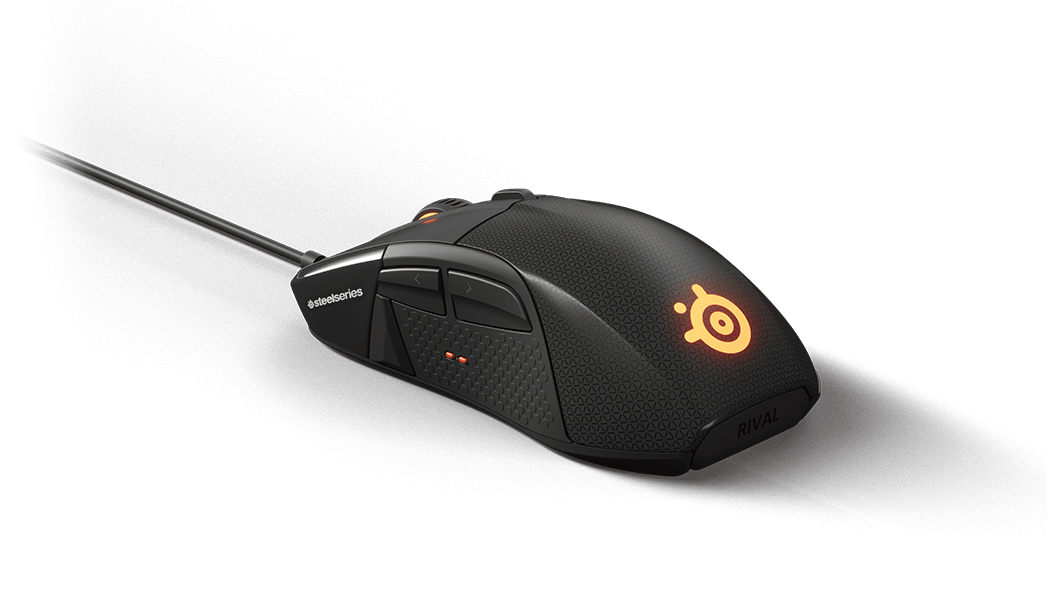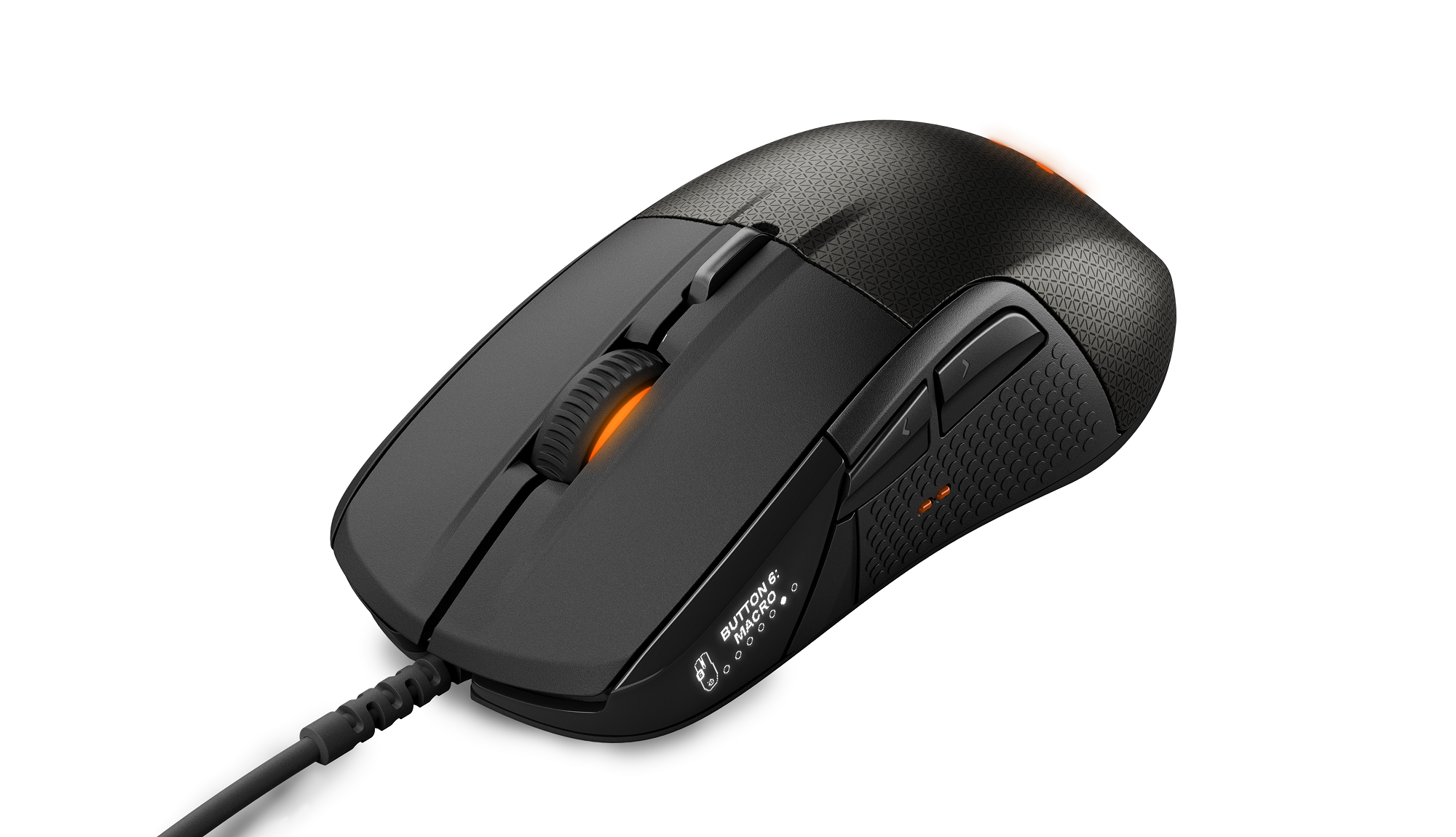For the modern PC gamer, choosing a good gaming mouse isn’t just about functionality and performance. More and more, it’s equally about customizability and distinguished aesthetic.
With hyper-personalization in vogue across the market via RGB lighting, infinitely programmable buttons, and granular DPI dialing, the SteelSeries Rival 700 crashes through the gates brandishing a few new weapons in the ever-escalating peripherals arms race.
Some of these additions are competent and exciting, letting the mouse take interesting steps forward on the tech front, but others seem more like gimmicks than truly useful iterations. In a world flooded with gaming mice and other must-have peripherals, the Rival 700 pulls off its ideas well enough to stand out, even if those ideas function in some situations better than others.
The Rival 700’s Design
The right-handed Rival 700 isn’t the biggest gaming mouse on the market, though its relatively hefty size had me worried it might not comfortably fit my hand or playstyle. Those worries were quickly laid to rest, though, the Rival 700’s side buttons are awkwardly placed, to put it lightly.
The back-most thumb button is easily pressed if using a palm-grip style, even if you don’t mean to. And no matter which style you choose, the front thumb button is woefully out of reach. You’ll have to completely shift your grip to press it 100% of the time. It’s not a deal-breaker, of course, but it feels like an oversight for a mouse that’s obviously been meticulously engineered.
Customizing the Rival 700
Like many modern mice, the Rival 700 features myriad customization options, some right out of the box and others after you’ve downloaded SteelSeries’ Engine 3 software.
Modular Customization
Out of the box, the Rival 700’s modular design lets you choose between a 6-foot braided cable and a 3-foot plastic cable. Changing these out is a breeze, requiring no more effort than unplugging one from the front of the mouse and plugging the other in. On top of that, you’re also able to easily change out the mouse’s backplate, although you’ll have to plunk down some extra cash to do so.
For $14.99, you can nab SteelSeries’ Cover Pack, which features one glossy black backplate and one matte black backplate. And for $19.99, you can purchase the Cover Color Pack, which features red, blue, and white backplates. Both seem like pricey additions for a mouse that already retails at $99.99, but having the option to change things up is a nice touch if you’re into that sort of thing.
And for what it’s worth, there’s also a customizable nameplate on the back of the Rival 700 that lets you emblazon the mouse with anything from your name to your favorite phrase.
RGB Customization
As for tailoring the Rival 700’s RGB lighting options, there are plenty of available avenues as SteelSeries’ Engine 3 lets you choose from more than 16.8 million colors and five different illumination effects. These can be selected for the whole mouse or for individual sectors, such as underneath the mouse wheel or for the SteelSeries logo on the Rival’s backplate. If you’ve owned — or even tinkered with — an RGB mouse before, you know what’s going on here.
DPI Customization
For DPI, the 700 doesn’t reinvent the wheel but instead provides you with the granular sensitivity options you’ve come to expect from modern gaming mice. It allows for two distinct DPI (CPI) settings — each ranging from 100 to 16,000 — which you can easily switch between with the DPI toggle just below the mouse wheel. And based on your preference of laser sensor vs. optical sensor, you can easily switch the 700’s stock PixArt PMW 3360 optical sensor for a PixArt 9800 laser sensor simply by removing four screws on the bottom of the mouse.
OLED Display Customization
An interesting (if odd) addition to the Rival 700 is the inclusion of a white and black OLED screen on the front-left corner of the mouse. Using Engine 3, you can display a 128×36 logo or GIF on the screen, either of your own making or from SteelSeries’ small pre-made selection.
But that’s not the only use for the screen; you can also display in-game information, such as your K/D, and your current DPI settings. The problem is that the screen is so small that it’s near impossible to see during a firefight or frenetic arena battle. And since the only games that display real-time in-game information are those included with Engine 3, your options are terribly limited until SteelSeries adds more supported games to the software.
Overall, it’s an interesting addition and shows that SteelSeries is constantly thinking outside of the box when engineering their mice (which is a very good thing), but the OLED display doesn’t really add anything of true value to the Rival 700. It’s more of a cool vanity item than anything truly revolutionary.
Haptic Feedback
Haptic feedback isn’t new technology, but the Rival 700 is one of the first gaming mice to implement the feature. As such, I was a bit dubious on the prospect of a rumbling mouse. Luckily, it’s not distracting, but it’s also not super useful.
Though, programming things outside of the included games can be a pain. It took me about 5 minutes to figure out that Victor’s grenade cooldown in Paladins was 8 seconds — and then I had to convert seconds into milliseconds to program the mouse. And that was just for one champion on a roster of 30, all who have different cooldown timers for various abilities.
It’s easy to see that this feature can get pretty cumbersome and inefficient when working outside of the designated Engine 3 games. And for games like SMITE, where CDR items and other abilities constantly buff and debuff cooldowns, it’s impossible to effectively program the Rival 700’s haptic feedback feature.
Verdict
The Rival 700 is a good mouse. Being the flagship of the SteelSeries line, it ought to be. It’s reliable. It’s accurate. It’s precise. It’s flexible. Thing is, a lot of other mice are, too, making it difficult to argue that the Rival 700 really does anything revolutionary to put it at the head of the pack. Its OLED display is fun, but not entirely useful. Its modular design is perfect for personalization but can get pricey for a mouse that starts at $99. And its rumble feature is innovative, but not ubiquitous (which is a huge bummer).
If you loved the Rival 500 from SteelSeries, the Rival 700 is a natural progression in that line and a must-buy. It is currently available on Amazon for $72.46. If you want a mouse that’s ready to rock right out of the box, you may want to check out SteelSeries’ other offerings, such as the Rival 310.
Note: SteelSeries provided the Rival 700 for this review.








Published: Aug 4, 2017 09:58 am